
Hungary
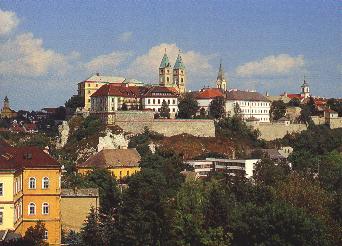
The city is built on seven hills, and the Romans settled in the area. It grew into a centre of one of the chieftans who was defeated by King Stephen in his quest to unite Hungary under christian rule. His queen Gisela (a princess from Bavaria) founded a bishopric here in 1001 and the queens of Hungary were patrons of the cathedral, had a throne and crown for them kept in the cathedral and the bishop crowned each new queen. The cathedral and bishop's palace stand within the old castle or Vár along with many other old buildings. The city was conquered in 1552 by the Turks and the bishops fled to Sümeg. This and subsequent battles damaged or destroyed many of the buildings and in the C18 the rebuilding took on a baroque feel and many of the old streets were eliminated. Today the old Vác area is a traffic-free zone and all the churches below are to be found here.
Cathedral of St Michael
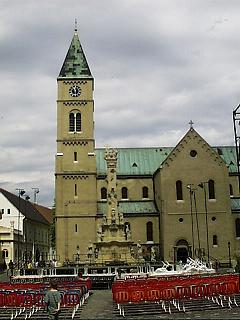
The twin towers of the cathedral are the tallest building on the skyline of the old city. To the south in the rebuilding of the city a pleasant square was created with a large column depicting the Holy Trinity of 1750. On the day I visited, a stage was erected here with seating for an open-air concert. The cathedral appears to be a Romanesque building with west towers, short nave transepts and choir with a Gothic apse. However the guidebook shows a very different church before the "restoration" of 1907-10. There are baroque towers with a pediment between, and a basilican church of clerestoried nave and aisles terminating in an apse. This was "returned to the original C12 appearance" and indeed some of the features are original (largely to be seen in the lower parts of the external walls), but very few. Certainly the transepts are totally new.
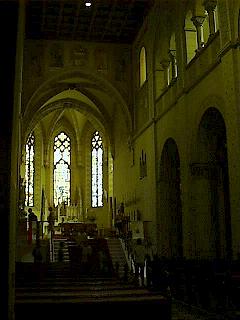
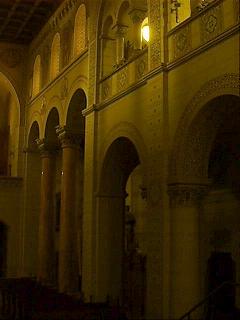
The inside of the cathedral is one of the darkest I have ever been in, and this was on a bright sunny day too. This is in part due to the profusion of yellow glass in many of the windows. The features are mainly fake, especially the first three bays of the nave, with their tall polished columns. The rest is shown on the plan to be C12 but terribly reworked if any feature is reliable. The lower vaulted choir too seems a little too good to be true. The latter is considerably raised over a crypt. Here is preserved a bone from the arm of Queen Gisela, a recent gift to the cathedral by the nuns at the Neumünster in Passau where she was buried.
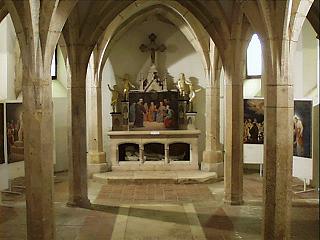
The crypt under the choir is C14 and rather attractive. On the right is a futher outer bay containing the elaborate monument of a former bishop.
To the north excavations have revealed remains of St George's Chapel, originally round with a bulbous sanctuary extension and then rebuilt octagonal and also with a bulbous sanctuary. The foundations are covered with a modern structure , and other architectural remains are displayed here.
Much of the former treasure of the church, together with medieval staues etc are on display in the Queen Gisela Museum close to the cathedral west doors. The bishop's palace and this museum can be visited by buying a joint ticket for a minimal sum, and the palace alone is amazing.
Franciscan Church
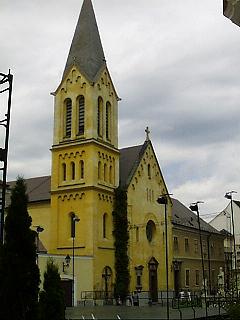
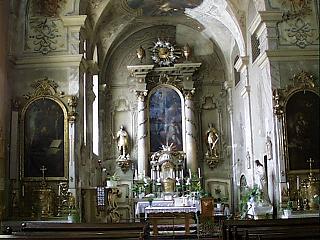
Also in Holy Trinity Square is the Franciscan church. From the outside with its new facade and ugly tower of 1909 (following a fire), it is a surprise to glimpse the interior from the vestibule. This is still the 1730 baroque church.
Gisela Chapel
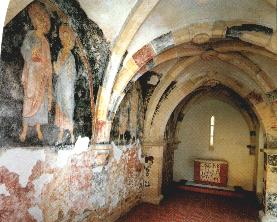
On the opposite side of the square is the small Gisella Chapel, a name given to it in the C18. This small C13 vaulted chapel has a two-bayed nave, sanctuary and a small vaulted sacristy to the north. The window is C20. There are six life-size figures of saints surviving among the wall-paintings. This was probably an undercroft to the chapel of the bishop's palace.
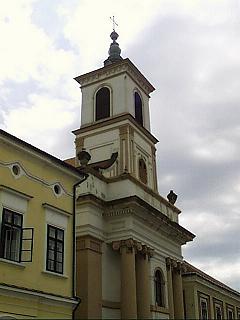
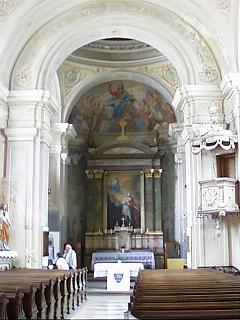
The final church in the old city is the Church of the Piarist Order. In comparison to the huge monastic building alongside , the church is relatively modest. The facade is dated 1828 but the church behind looks older to me. It has lovely frescoes.
Back to the Hungary Pages Intro and Index